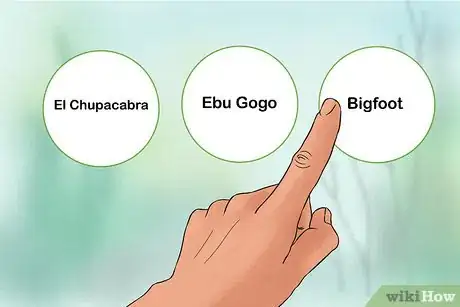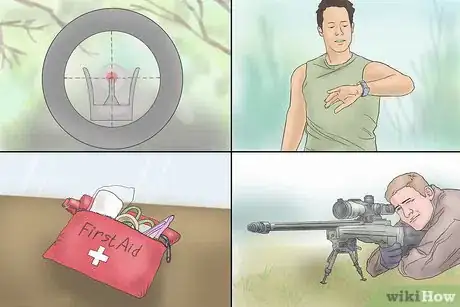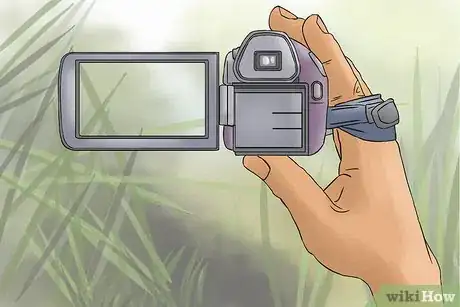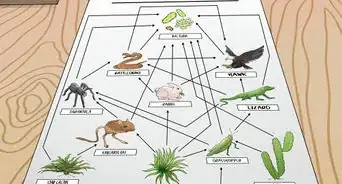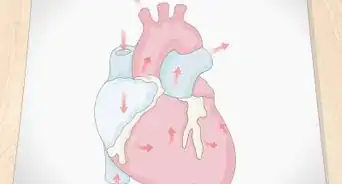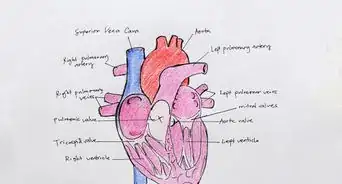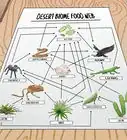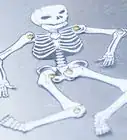This article was co-authored by wikiHow Staff. Our trained team of editors and researchers validate articles for accuracy and comprehensiveness. wikiHow's Content Management Team carefully monitors the work from our editorial staff to ensure that each article is backed by trusted research and meets our high quality standards.
There are 11 references cited in this article, which can be found at the bottom of the page.
This article has been viewed 65,543 times.
Learn more...
Cryptozoology is the study of animals that have been seen but not proven to exist. These animals are called cryptids. There is no qualification or certification to become a cryptozoologist, but it’s a fun hobby with a large and enthusiastic community. To enter this field, you need to do extensive research on a particular cryptid. Once you know as much as possible, you can go out to hunt the cryptid itself. Anything you find, you should publish so that other cryptozoologists can learn about your exciting new discoveries.
Steps
Deciding to Become a Cryptozoologist
-
1Determine if cryptozoology is right for you. In many cases, cryptozoology is not a career. The study of cryptids is an interesting pastime for some and a passion for most. Few people can get any income from searching for creatures.[1]
- Even if you manage to publish a book on cryptozoology, you may not make much money. Cryptozoology for most people is a passion, not a career.
- Keep in mind that much of cryptozoology consists of travel. It is recommended that you do not pursue this field if you do not like to travel.
- Cryptozoology can be an expensive hobby. Some common costs include travel, recording equipment, and DNA testing on samples.
-
2Choose a cryptid to specialize in. While you may have a general interest in cryptids, you might want to choose one or two cryptids to focus your research on. You might choose based on geographical region or type of animal (hominid, sea creature, primate, etc.). Some cryptids you might consider include:
- Bigfoot: This cryptid is also known as a yeti, Sasquatch, or skunk ape. While many believe that bigfoot is not real, some speculate that it is really an undiscovered giant primate.[2] Since big foot sightings are reported around the world, this may be a good place to start if you cannot travel far.
- El Chupacabra: El Chupacabra is a creature believed to live in South America. They are reported to suck the blood of livestock.[3]
- Ebu Gogo: the ebu gogo is a small, human-like creature that exists within the folklore of Indonesia. It is very aggressive and will eat anything.[4]
Advertisement -
3Study many different fields. Cryptozoologists often need expertise in many different fields. Try reading up on as much biology, zoology, psychology, anthropology, and conservation as you can. This will help you understand the behavior and biology of certain cryptids.
-
4Learn survival skills. Most fieldwork involves going to isolated and uninhabited areas to search for cryptids. To make sure that you can survive in these regions, train yourself in wilderness survival, first aid, hunting, and other useful techniques.
- Pick up skills that will help hunt your specific cryptid. For example, if you are interested in the orang pendek of Sumatra, you may want to learn to speak Indonesian. Since it lives in trees, you may want to practice climbing trees.[7]
Researching a Cryptid
-
1Read field reports by other cryptozoologists. Once you have decided to focus on a particular cryptid, you should do as much research as you can on the creature. Other cryptozoologists have likely done work on this cryptid. Start by reading field reports, books, and studies done on the cryptid.
-
2Learn what scientists say about the cryptid. While you should read texts by cryptozoologists, you should also do some scientific and anthropological research as well. Find out what scientists think so that you can consider both sides of the argument.
- For example, many scientists think that most cases of El Chupacabra are really just coyotes with mange.[8]
-
3Look into folklore. Many stories about cryptids are recorded in local folklore, myths, and urban legends. Read the folklore of the region you are travelling to. These stories can tell you the various names for the cryptid, what it eats, where it lives, what time of day it comes out, and how to find one.
-
4Study the geography of the area. Many cryptids hide within natural features of their environment, such as trees or caves. Many are well-adapted to their regions. To make sure you that you can successfully find the cryptid, examine the geographical features of its natural habitat.
- For example, if you are going after the Loch Ness Monster, look into the geographical features of the Loch Ness area, such as the Great Glen Fault and the River Ness.
Hunting for Cryptids
-
1Plan your travel. If your cryptid lives in another part of the world, you should start saving some money to visit it. Research the specific areas where the creature lives.
- Plan to give yourself plenty of time in the area to search for the creature. You probably will not encounter them in a day or two.
- You should only travel far away if you believe that the creature really does exist. If you are uncertain, you may not want to spend the money, or you may decide to look for a cryptid closer to home.
-
2Pack for the expedition. Whether you are traveling far away or close to home, you should pack the proper supplies for your journey. What you need may vary based on where you’re traveling and which cryptid you are looking for. In general, you will need:
- Camera and recording equipment
- Audio recorder
- Sterile collecting bottles, vials, and bags
- Latex gloves
- Markers to label samples
- Ruler and/or measuring tape
- Magnifying glass
- Logbook or journal[9]
-
3Find local witnesses. You should listen to what other people have seen and heard about the creature.[10] You can ask local librarians, policemen, town officials, and historians.These eyewitness accounts can give you clues about how to find the cryptid.
- Some questions you might want to ask include: “What can you tell me about the bunyip?”; “Have you seen a bunyip yourself? If so, where?”; and “How does one find a bunyip?”
- If you are about to head out into the wilderness or if you are in an unfamiliar part of the world, you may want to consider hiring a local guide.
-
4Perform fieldwork. Fieldwork is the process of collecting evidence while out in the areas where the cryptid lives. Fieldwork includes taking samples, recording audio and video, and tracking footprints.
- Take pictures of everything. If the creature is shy, you can set up a camera with an automatic timer, and leave the area for a while.
- If you find feces, bone, or hair, use tweezers to place the sample in a bag. Label each bag with what it is, when you collected it, and where you found it.
- If you find a footprint, measure it with a ruler or tape measure. Take a picture of the footprint with the ruler beside it.
- Write everything down. Keep a log book of everything that you do, see, hear, and find. Be as detailed as possible.
-
5Recognize that there is a possibility that the cryptid may not exist. Sometimes you may arrive at the conclusion that your cryptid does not exist. All is not lost, however. You can simply enjoy the fact that you had an interesting experience.
Publicizing Your Work
-
1Start a blog. The easiest way to talk about your cryptozoological work is to start an online blog. Publish pictures, DNA test results, recent sightings, and speculation. If you kept a log book during your fieldwork, you can publish entries from the logbook.
- If you keep comments open on your blog, you can hear from other cryptozoologists. They may have information related to one of your mysteries.
- Blogs are also a great way to solicit donations for your travels and research.
-
2Write a book. While you may not become rich writing a cryptozoological book, you can make a little extra money on the side.[11] A book requires extensive research. You can publish it traditionally or make an ebook.
-
3Reach out to other cryptozoologists. There is a large community of active cryptozoologists who would love to hear about your research and findings. Online forums, blogs, and newsletters regularly advertise the latest discoveries. You may even find other people to form a research team with.
- Look to see if there is a cryptozoological association in your local area. If there is not, you might try starting one yourself.
Community Q&A
-
QuestionWhat colleges offer programs for this course of study?
 SnapplebabyCommunity AnswerThere is a list of colleges that offer courses or degrees in cryptozoology here: http://cryptomundo.com/cryptozoo-news/cz-courses/
SnapplebabyCommunity AnswerThere is a list of colleges that offer courses or degrees in cryptozoology here: http://cryptomundo.com/cryptozoo-news/cz-courses/
Warnings
- This research field is dangerous. Many cryptozoologists have died or have come close to death on expeditions because they were not prepared or they did not have a working knowledge of first aid or survival.⧼thumbs_response⧽
- Cryptozoology research can be very expensive. There are no scientific grants currently available to cryptozoologists. Many researchers pay with their money or with donations.⧼thumbs_response⧽
References
- ↑ https://exemplore.com/cryptids/What-is-Cryptozoology-and-How-Do-You-Become-a-Cryptozoologist
- ↑ https://exemplore.com/cryptids/Is-Bigfoot-Real-Bigfoot-Facts-and-Theories-for-Skeptics
- ↑ http://www.livescience.com/24036-chupacabra-facts.html
- ↑ http://www.phantomsandmonsters.com/2010/08/legendary-humanoids-ebu-gogo-flores.html
- ↑ https://cryptidz.fandom.com/wiki/Category:Aquatic-based_Cryptid
- ↑ http://mysteriousuniverse.org/2013/08/what-qualifications-are-required-to-be-a-cryptozoologist-part-1/
- ↑ https://exemplore.com/cryptids/Orang-Pendek-Sightings-Evidence-of-a-New-Species-of-Hominid
- ↑ https://www.nationalgeographic.com/culture/article/101028-chupacabra-evolution-halloween-science-monsters-chupacabras-picture
- ↑ https://www.anspblog.org/packing-for-an-expedition/

